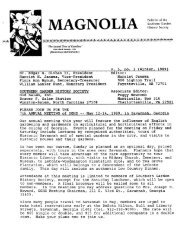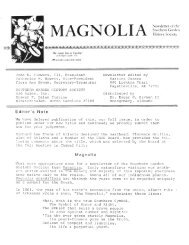Vol. XII, no. 2, 3 & 4 - Southern Garden History Society
Vol. XII, no. 2, 3 & 4 - Southern Garden History Society
Vol. XII, no. 2, 3 & 4 - Southern Garden History Society
You also want an ePaper? Increase the reach of your titles
YUMPU automatically turns print PDFs into web optimized ePapers that Google loves.
<strong>Garden</strong>s of<br />
Blennerhassett<br />
Island<br />
. . . continued from page 1 0<br />
decorated on the interior side with<br />
espaliers of peach, apricot, quince ,<br />
and pear trees, and gooseberry<br />
hushes. Toward the center of th e<br />
garden wound serpentine grave l<br />
paths that, bordered by "thick mass -<br />
es" of shrubs, passed under bowers<br />
and arbors of honeysuckles an d<br />
eglantine roses. Some of the shrubs<br />
were imported from abroad; other s<br />
were selected with great care from<br />
the adjacent forest .<br />
The paths led to ornamenta l<br />
summerhouses or gazeboes wher e<br />
strollers could sit to rest and admir e<br />
the view. A maze or labyrinth of<br />
high hedges added an air o f<br />
mystery . The garden's trees and<br />
shrubs were mirrored in the waters<br />
of a fish pond. All in all, the garde n<br />
was surely worthy of the accolad e<br />
given it by English actor John<br />
Bernard in 1801 who called it "thi s<br />
Italy of the West," adding that " . . .<br />
until I go to my grave I must hea r<br />
with me, as of a dream, the<br />
remembrance of the beautifu l<br />
Blennerhassett . . . the Paradise . "<br />
These accounts had led us to<br />
assume that the gardens of the well -<br />
read and widely-traveled<br />
Blennerhassett reflected th e<br />
naturalistic gardening styles then<br />
popular in Britain. Imagine our<br />
surprise upon the discovery of a n<br />
account in the Zanesville Gazette,<br />
published October 18, 1843 . The<br />
article, by a man who visited the<br />
island while the Blennerhassetts<br />
were still in residence, described th e<br />
area in front of the crescent-shaped<br />
mansion: "The space in front of th e<br />
principal building, and between the<br />
two wings, was set in flowers . On<br />
the <strong>no</strong>rth, between the house an d<br />
river, was the shrubbery, laid out in<br />
such a manner as to represent th e<br />
thirteen states of the Confederacy !<br />
gravelled walks, answering to<br />
boundary lines! This was the<br />
shrubbery which Wirt says `eve n<br />
Shenstone might have envied' . "<br />
This article contains the firs t<br />
mention of a parlor garden that we<br />
have seen, changing our concept of<br />
an expansive grass lawn in front of<br />
the mansion. The late eighteenth -<br />
and early nineteenth-century<br />
practice of growing flowers in front<br />
of the house might easily hav e<br />
captured the imagination of Margare t<br />
Blennerhassett .<br />
The most intriguing aspect of<br />
the article, however, is the reference<br />
to the area "laid out in such a<br />
manner as to represent the thirtee n<br />
states of the Confederacy!" Coul d<br />
this possibly be referring to th e<br />
maze of high hedges <strong>no</strong>ted in a n<br />
earlier visitor account to the island ?<br />
Certainly it seems to indicate a<br />
highly developed imagination on th e<br />
part of the designer. One wonders ,<br />
however, what Shenstone, who<br />
embraced the naturalistic movement ,<br />
might have envied in such a garden .<br />
It is obvious that much research<br />
needs to be done before the<br />
Blennerhassett gardens can b e<br />
restored. The Blennerhassett<br />
Historical Foundation, Inc ., recently<br />
initiated a program to begin agai n<br />
the archeological work that had<br />
been interrupted in the 1980s . An<br />
archaeologist has been retained wh o<br />
will work with field school students<br />
from West Virginia University to<br />
complete a professional dig of th e<br />
garden area. The Parkersburg community<br />
and representatives fro m<br />
WVU are enthusiastic and supportiv e<br />
of this opportunity .<br />
Only when the gardens are<br />
complete can the mansion be seen<br />
as it was for the few glorious years<br />
that the Blennerhassetts reside d<br />
there. Eventually, the restore d<br />
gardens will take their rightful place<br />
as the proper background of th e<br />
romantic Bennerhassett story . +<br />
A correction to Flora Ann Bynum's article "A Plant List for the South" (<strong>Vol</strong> . <strong>XII</strong>, No. 3). While most SGHS members<br />
are familiar with our vice-president, Peter Hatch, we did <strong>no</strong>t mean to omit his last name in the article .]<br />
Editors<br />
Notes Two corrections for the illustrations in Michael Trostel's article "The Maryland Orangeries" (<strong>Vol</strong> . <strong>XII</strong>, No. 3) .<br />
The captions for the Robert Cary Long, Jr. watercolor of Hampton Mansion (p . 3) should <strong>no</strong>te of the original<br />
painting "Present whereabouts unk<strong>no</strong>wn, "and the elevation and plan of the Wye House Orangery (p . 4) i s<br />
from The Mo<strong>no</strong>graph Series, No. 5, <strong>Vol</strong>. XVI, 1930 . ]<br />
11
















